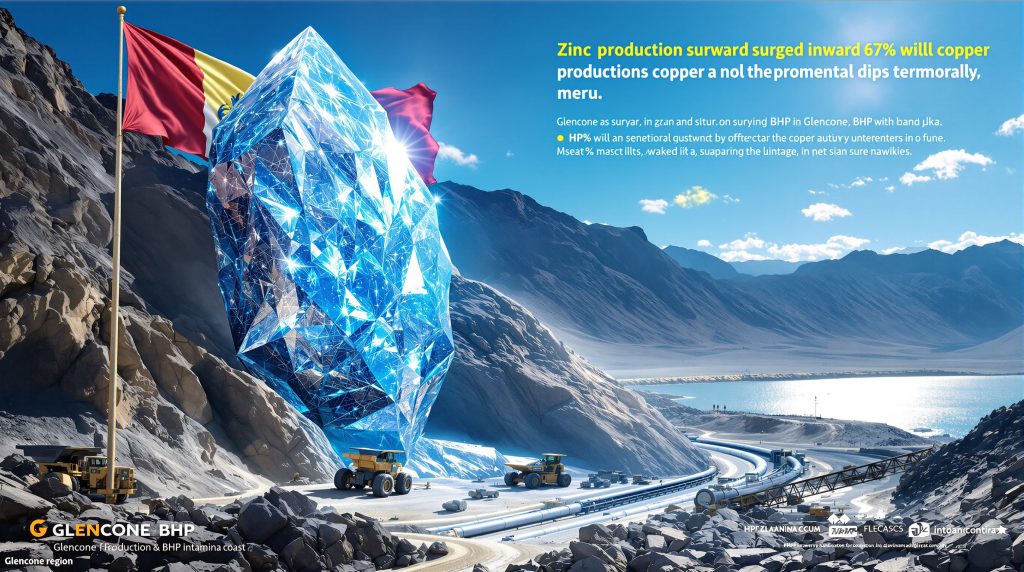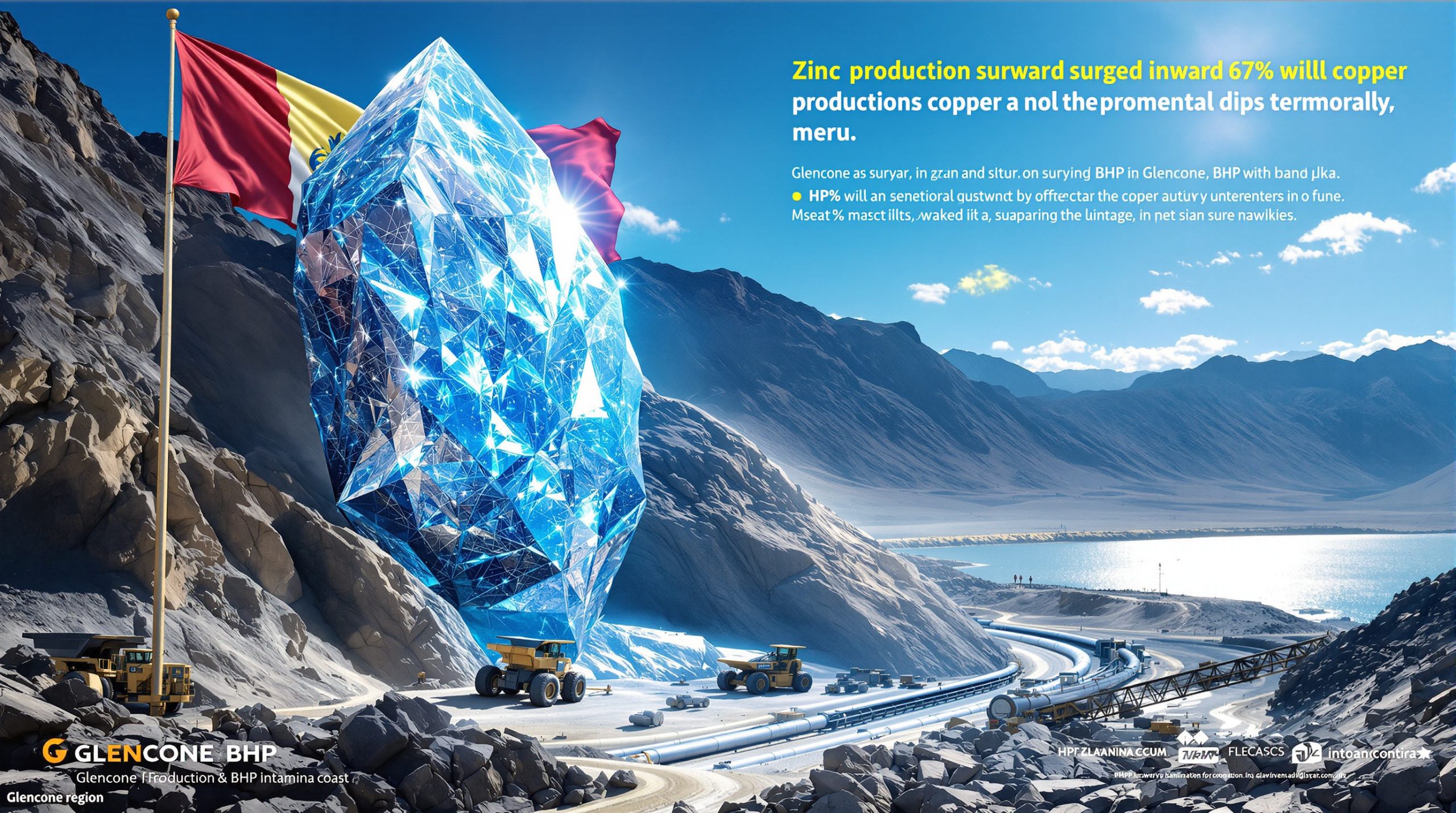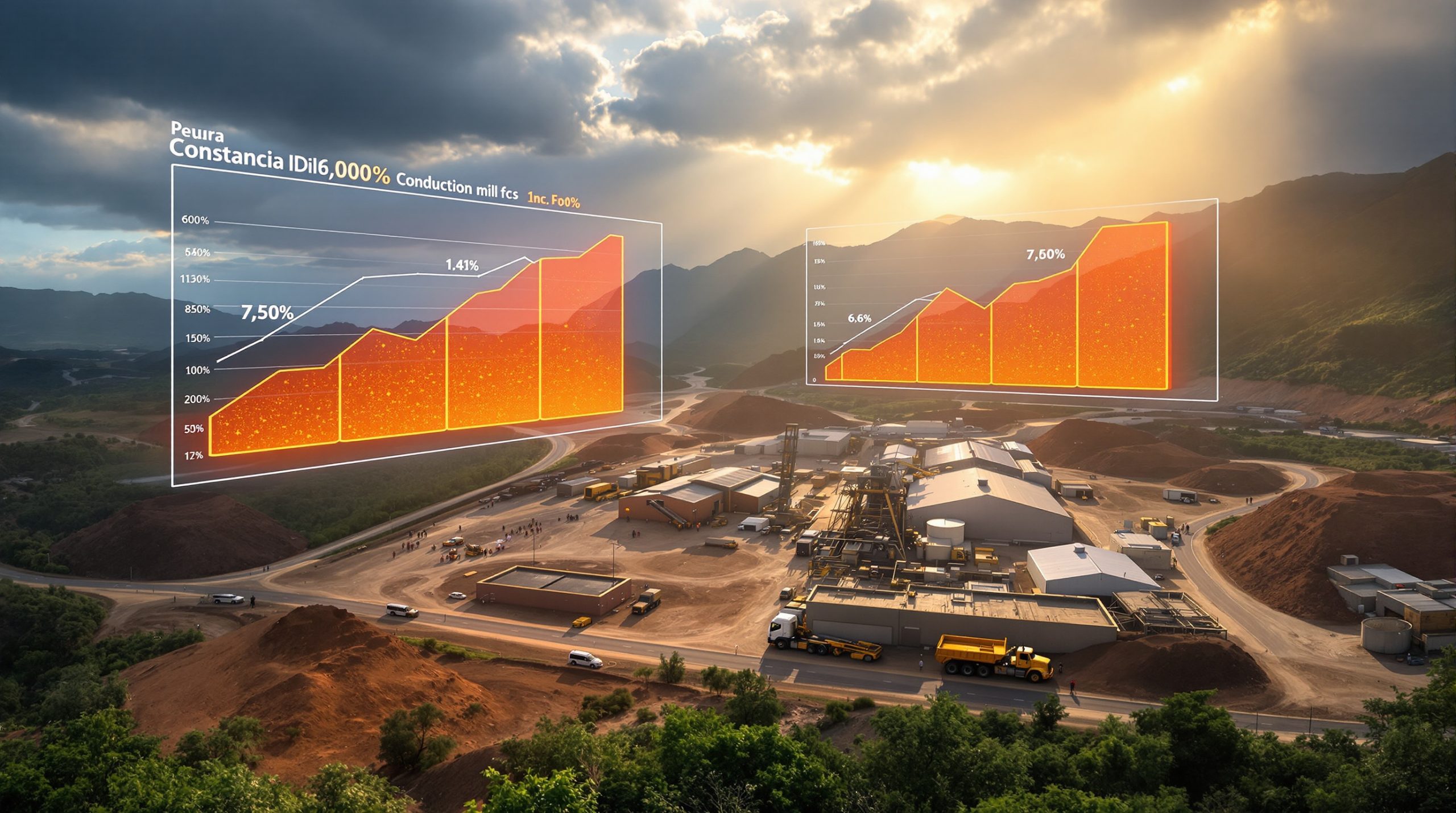Antamina's Strategic Zinc Production Surge: Balancing Output in Peru's Mining Giant
The mining landscape in Peru is experiencing a significant shift as one of its largest operations recalibrates its production focus. The Antamina mine, a cornerstone of Peru's mineral output, is strategically increasing its zinc production while managing a temporary reduction in copper. This calculated adjustment showcases the flexibility of polymetallic mining advantages and their ability to navigate changing market conditions and ore compositions.
What is Driving Antamina's Zinc Production Increase?
The Significant Production Shift
Antamina's zinc production is set to surge dramatically in 2025, increasing by 67% to reach approximately 450,000 metric tons compared to 270,000 tons in the previous year. This substantial growth comes as part of a deliberate operational strategy by the mine's controllers, Glencore and BHP, who are adapting the production focus to maintain overall output value during a period of changing ore composition.
The mine, located in Peru's Áncash region, is implementing this significant adjustment as part of its long-term resource management approach. This shift demonstrates how large-scale mining operations can adapt their production priorities based on geological realities while optimizing economic returns.
Mine Sequencing and Ore Composition
The dramatic increase in zinc production directly results from Antamina's mine sequencing plan, which has encountered more zinc-rich ore bodies in current extraction zones. This isn't merely a market-driven decision but rather a geological necessity based on the natural distribution of minerals within the deposit.
Mining engineers at Antamina have carefully mapped the various ore zones, recognizing that different sections of the deposit contain varying concentrations of zinc and copper. This natural variability is common in mineral deposit tiers, where metal content can change significantly as mining progresses through different geological formations.
The current extraction zones contain substantially higher zinc content than previous areas, requiring the operation to adjust its processing parameters to efficiently recover this valuable metal. This represents a tactical approach to resource management that maximizes the value of the available ore body.
Copper Production Temporary Decline
While zinc production rises significantly, copper output at Antamina is projected to decrease by 12% in 2025, falling to 380,000 tons from 430,000 tons in the previous year. This reduction reflects the changing mineral composition in the current mining zones rather than any operational issues or market-driven decisions.
The copper production decline appears to be temporary in nature. According to operations director Luis Santivanez, copper production trends suggest output is expected to rebound to approximately 450,000 tons by 2026 as the mine progresses to different areas of the deposit with higher copper content. This cyclical pattern of production showcases the natural variability within large polymetallic deposits and the importance of long-term mine planning.
Mining engineers and geologists continuously monitor the grade distribution throughout the deposit to optimize extraction sequencing and processing parameters, ensuring that both zinc and copper recovery rates remain at optimal levels despite changing ore characteristics.
How Does This Shift Impact Peru's Mining Sector?
Peru's Position in Global Zinc Markets
Peru already ranks as one of the world's largest zinc producers, with significant operations throughout the country contributing to global supply. Antamina's substantial production increase will further solidify Peru's position as a zinc powerhouse in global markets.
The additional 180,000 metric tons of zinc production from Antamina represents a meaningful contribution to Peru's overall output. Industry projections suggest this could help increase the country's total zinc production by approximately 3% annually in coming years, with Antamina serving as the primary growth engine.
This production boost comes at a time when zinc remains an essential industrial metal, primarily used in galvanizing steel to protect against corrosion. Peru's strengthened position in the zinc market helps diversify its mining sector, which has traditionally been more heavily focused on copper.
Economic Implications for Peru
The strategic timing of Antamina's production shift carries significant economic implications for Peru. The mining sector represents a crucial component of the national economy, contributing substantially to GDP, export revenues, and tax income.
By maintaining overall production value through increased zinc output while copper temporarily declines, Antamina helps stabilize the economic contributions from this important operation. The tax revenues and royalties generated from mining activities provide essential funding for public services and infrastructure development throughout Peru.
Additionally, the production shift demonstrates the resilience of Peru's mining sector in adapting to changing mineral compositions and market conditions. This adaptability is crucial for long-term economic sustainability in a country where mining represents a significant portion of economic activity.
Regional Development in Áncash
Antamina's operational changes will likely influence economic activity throughout the Áncash region, where the mine serves as a significant employer and economic driver. The mine is located in the Huari Province of Áncash, approximately 200 kilometers from Lima.
The production increase may necessitate adjustments to processing facilities and potentially create additional employment opportunities in the area. Local businesses that support mining operations could see increased activity as production volumes rise, creating a multiplier effect throughout the regional economy.
Beyond direct employment, Antamina's social investment programs in the region may benefit from maintained production value, supporting continued community development initiatives, educational programs, and infrastructure improvements that benefit local communities.
What Market Factors Support This Production Strategy?
Current Zinc Market Conditions
The timing of Antamina's zinc production increase aligns advantageously with global zinc market dynamics. Industry analysts note that zinc concentrate supplies have remained relatively tight in recent periods, creating favorable economics for producers who can increase output.
Zinc prices have shown resilience despite economic uncertainties in various global markets. As an essential industrial metal used primarily in galvanizing steel and die-casting alloys, zinc benefits from infrastructure development and construction activities worldwide. The metal's anti-corrosion properties make it particularly valuable in harsh environmental conditions.
Recent supply constraints from some major zinc-producing regions have created market conditions that support Antamina's increased production. Several older zinc mines globally have experienced declining grades or are approaching end-of-life, making new sources of production particularly valuable to the market.
Strategic Metal Balancing
The decision to increase zinc production while copper temporarily decreases represents a sophisticated approach to metal balancing within a polymetallic operation. This flexibility allows Antamina to optimize revenue streams based on both available ore composition and prevailing market conditions for different metals.
Mining operations with diverse mineral content gain a significant competitive advantage through this ability to adjust production focus. When one metal experiences price pressure or when ore grades for a particular metal decline in certain zones, the operation can pivot to emphasize other valuable minerals present in the deposit.
Antamina's management team continuously evaluates the optimal production mix based on metallurgical recovery rates, processing costs, and market prices for each metal. This dynamic approach to production planning helps maximize the overall economic value generated from the operation.
Comparison with Other Major Zinc Producers
Antamina's projected 450,000 tons of zinc production in 2025 places it among the world's largest zinc operations. For context, this output level exceeds the total zinc production of many zinc-focused mining companies and represents a significant portion of global primary zinc supply.
Traditional zinc-focused operations like Red Dog in Alaska (operated by Teck Resources) and McArthur River in Australia have historically dominated global zinc production. However, polymetallic operations like Antamina are increasingly important contributors to global zinc supply, offering production flexibility that single-metal mines cannot match.
The zinc concentrate produced by Antamina likely commands premium prices in the market due to its typically clean metallurgical characteristics. Many zinc smelters prefer concentrates with low levels of deleterious elements, making high-quality concentrates particularly valuable in tight market conditions.
How Are Ownership Partners Managing This Transition?
Stakeholder Coordination
The production shift requires careful coordination among Antamina's ownership partners, which include Glencore (33.75%), BHP (33.75%), Teck Resources (22.5%), and Mitsubishi Corporation (10%). Each partner has different portfolio exposure to zinc and copper, making this production rebalancing strategically important for their respective metal production profiles.
These major mining companies must align on investment decisions, operational priorities, and marketing strategies for the additional zinc concentrate. Regular board meetings and technical committee reviews ensure all stakeholders remain informed about production plans and market developments affecting the operation.
The collaborative management approach at Antamina has proven effective over decades of operation, allowing the partners to navigate changing market conditions and ore compositions while maintaining strong operational performance and safety standards.
Teck Resources' Production Share
Based on its 22.5% ownership stake, Teck Resources expects to receive between 95,000 and 105,000 tonnes of zinc from Antamina in 2025. This allocation aligns with the company's production guidance that reflects the planned increase in zinc-rich ore processing compared to projected future years.
For Teck, which operates several significant zinc mines including the Red Dog mine in Alaska, the increased zinc production from Antamina provides a valuable complement to its existing zinc portfolio. The company leverages this diversity of zinc sources to maintain reliable supply relationships with smelters worldwide.
In investor communications, Teck has acknowledged the cyclical nature of Antamina's zinc and copper production, incorporating these expected fluctuations into its long-term metal production forecasts and financial planning.
Glencore's Zinc Portfolio Enhancement
For Glencore, which reported a significant zinc production increase in the first half of 2025, the additional zinc output from Antamina represents an important enhancement to its global zinc portfolio. This helps offset production challenges the company has experienced at some other zinc operations.
Glencore maintains one of the world's largest zinc trading operations, giving it particular insight into market dynamics and customer requirements. This market intelligence likely informs Antamina's production decisions, helping to optimize the timing of increased zinc output.
The company's integrated business model allows it to capture value throughout the zinc supply chain, from mining through smelting and refining to metal trading. Antamina's high-quality zinc concentrate provides valuable feed material for Glencore's zinc smelting operations.
What Technical Challenges Does This Production Shift Present?
Processing Facility Adjustments
The substantial increase in zinc processing requires technical adjustments to Antamina's mineral processing facilities. The operation must optimize its flotation circuits to efficiently separate zinc minerals from copper and other metals, potentially requiring modifications to reagent regimes and processing parameters.
Mineral processing engineers must carefully balance grinding fineness, reagent dosages, and flotation residence times to maximize zinc recovery while maintaining concentrate quality. The flotation chemistry for zinc minerals differs from that used for copper, requiring precise control of pH levels, activators, and collectors.
These technical adjustments require extensive metallurgical testing and process optimization to ensure high recovery rates and concentrate grades. Engineers constantly monitor key performance indicators and make real-time adjustments to accommodate variations in ore characteristics.
Metallurgical Complexity Management
Zinc-rich ores often present different metallurgical characteristics than copper-dominant ores, potentially affecting recovery rates and concentrate quality. The primary zinc mineral at Antamina is sphalerite (ZnS), which requires different processing approaches than the chalcopyrite (CuFeS₂) that contains most of the copper.
Managing these metallurgical complexities involves sophisticated ore blending strategies, where material from different mining zones is combined to create a more consistent feed to the processing plant. This helps stabilize recovery rates and product quality despite variations in the incoming ore.
Advanced process control systems using real-time sensors and machine learning algorithms help operators respond quickly to changing ore characteristics, maintaining optimal performance despite the increased complexity of processing more zinc-rich material.
Logistics and Transportation Considerations
The significant increase in zinc production volumes necessitates adjustments to Antamina's logistics chain. The operation utilizes a 302-kilometer slurry pipeline to transport mineral concentrates from the mine site to the port facility at Huarmey on Peru's coast.
This pipeline system must accommodate the increased zinc concentrate volume, potentially requiring adjustments to pumping parameters, slurry density, and maintenance schedules. At the port, additional storage capacity and ship loading capabilities may be needed to handle the higher production volumes.
Transportation arrangements for shipping the concentrate to smelters worldwide require careful planning, especially given global shipping constraints that have affected many commodity markets. Long-term contracts with shipping providers help secure reliable capacity for the increased production.
What Are the Long-Term Implications for Antamina?
Mine Life Extension Efforts
According to operations director Luis Santivanez, management is actively working on extending the life of the Antamina deposit. This suggests that current production adjustments are part of a broader strategic plan to optimize the long-term value of the operation.
Mine life extension typically involves extensive mineral exploration insights and drilling to identify additional mineral resources beyond the current mining plan. Geologists use advanced modeling techniques to identify potential extensions of known ore bodies and discover new mineralized zones within the property boundaries.
Modern mining operations increasingly employ sophisticated technologies such as drone-based magnetic surveys, 3D seismic imaging, and artificial intelligence-assisted geological modeling to identify previously overlooked mineral deposits, potentially extending productive operations for years beyond original plans.
Production Cycle Expectations
Industry analysts note that Antamina's zinc production is expected to peak in 2025-2026 before gradually declining as the mine transitions back toward more copper-dominant ore zones between 2026 and 2028. This cyclical pattern reflects the natural variability in ore composition throughout different sections of the deposit.
Mining companies develop detailed long-term production plans that incorporate this expected variability, allowing them to make informed investment decisions and provide reliable guidance to stakeholders. These plans are continuously refined as new geological information becomes available through ongoing drilling and development work.
The cyclical nature of metal production at polymetallic mines like Antamina underscores the importance of maintaining operational flexibility. Processing facilities must be designed to handle varying ratios of different minerals, allowing the operation to adapt to changing ore characteristics throughout the mine's life.
Sustainability and Environmental Management
The production increase requires careful environmental management, particularly regarding water usage, tailings management, and energy consumption. Modern mining operations face increasing scrutiny of their environmental footprint, making sustainable practices essential for maintaining social license to operate.
Antamina has invested significantly in sustainability initiatives, including water recycling systems, renewable energy projects, and progressive reclamation programs. These initiatives must be scaled appropriately to accommodate the increased zinc processing volumes while meeting or exceeding regulatory requirements and community expectations.
The mine's environmental monitoring programs track key indicators such as water quality, air emissions, and biodiversity impacts, providing data to verify compliance with environmental standards and identify opportunities for continuous improvement in sustainability performance.
How Does This Compare to Historical Production Patterns?
Historical Production Fluctuations
Antamina has experienced significant fluctuations in its zinc-to-copper production ratio throughout its operational history due to the heterogeneous nature of its deposit. The current zinc production surge represents one of the more dramatic shifts in recent years but follows established patterns of variable metal output.
Since beginning operations in 2001, Antamina has adapted its mining and processing strategies to accommodate the changing mineral composition encountered as development progressed through different zones of the deposit. These adjustments represent a normal aspect of operating a complex polymetallic mine rather than a fundamental change in business strategy.
Historical production data demonstrates the natural cycles of metal output, with periods of higher zinc production typically alternating with periods of copper dominance. This variability is well understood by industry analysts who follow the operation and incorporated into production forecasts.
Previous Production Records
The projected 450,000 tons of zinc production in 2025 would set a new annual record for Antamina's zinc output, significantly exceeding previous high-water marks. This achievement highlights the operation's ability to adapt its production focus based on available ore characteristics.
Historically, the mine has experienced several periods of increased zinc production, though none as substantial as the current projected surge. Previous production increases typically ranged from 15-30% year-over-year, making the current 67% increase particularly noteworthy.
Setting new production records requires exceptional operational performance across mining, processing, and logistics functions. The ability to achieve these records while maintaining safety standards and environmental compliance demonstrates the technical capabilities of Antamina's management and workforce.
Comparative Performance Metrics
When examining production efficiency metrics such as zinc output per employee or per unit of energy consumed, the increased production volume may improve Antamina's overall operational efficiency for zinc. Economies of scale often lead to lower per-unit production costs as fixed costs are spread across higher output volumes.
Benchmarking these efficiency metrics against other major zinc producers provides valuable insights into Antamina's relative performance. Key performance indicators such as recovery rates, energy consumption per ton, and maintenance efficiency help identify areas for continuous improvement.
The operation likely tracks these metrics in detail, using the data to identify optimization opportunities and set performance targets. As zinc production increases, maintaining or improving these efficiency metrics becomes increasingly important for cost management and environmental performance.
What Are the Broader Industry Implications?
Impact on Global Zinc Supply
Antamina's additional 180,000 tons of zinc production represents a meaningful contribution to global primary zinc supply, potentially influencing market dynamics and price formation in the zinc concentrate market. This production increase comes at a time when several other major zinc mines are experiencing grade declines or approaching end-of-life.
Global zinc supply has faced various challenges in recent years, including regulatory restrictions in some producing regions, pandemic-related disruptions, and energy constraints affecting smelting operations. Antamina's production increase helps offset some of these supply limitations, potentially moderating price volatility.
Zinc concentrate market balance is particularly important for smelters, which require consistent feed material to operate efficiently. The additional high-quality concentrate from Antamina provides valuable supply security for smelters facing increasingly tight concentrate markets.
Polymetallic Mine Flexibility Demonstration
The significant shift in production focus demonstrates the inherent flexibility of large-scale polymetallic operations like Antamina, which can adjust their metal output mix in response to both geological factors and market conditions. This adaptability represents a competitive advantage compared to single-metal operations.
Mining companies increasingly value this operational flexibility as a risk management strategy. When market conditions for one metal deteriorate, polymetallic operations can often shift focus to other metals that offer better economics, helping maintain overall profitability despite market volatility.
This flexibility requires sophisticated technical capabilities in mineral processing, as different metals often require different mineral beneficiation opportunities. Investments in flexible processing circuits with multiple flotation lines and reagent systems enable these strategic production adjustments.
Benchmark for Other Operations
Antamina's successful management of this production transition may serve as a benchmark for other polymetallic operations globally that face similar variability in ore composition and seek to optimize their metal production profiles over time.
Mining engineers and metallurgists from other operations study these production shifts to gain insights applicable to their own operations. Technical conferences and industry publications often feature case studies highlighting successful adaptations to changing ore characteristics, creating valuable knowledge transfer throughout the industry.
The ability to maintain overall production value while transitioning between different metal focuses demonstrates operational excellence that other mining companies aspire to achieve. This includes not only technical proficiency but also effective stakeholder communication and market positioning.
FAQs About Antamina's Zinc Production Increase
How long will Antamina's increased zinc production last?
Based on current mine planning and sequencing, Antamina's zinc production is expected to peak in 2025-2026 before gradually declining as the operation transitions back to more copper-dominant ore zones between 2026 and 2028. This cyclical pattern reflects the natural distribution of minerals throughout the deposit rather than a permanent shift in production strategy.
The mine continues exploration and resource definition drilling to identify additional zinc-rich zones that could extend this production period. However, the heterogeneous nature of the deposit suggests that future production will continue to alternate between periods of higher zinc and higher copper output.
Long-term production forecasts remain subject to refinement as new geological information becomes available and as market conditions evolve. The operation maintains the flexibility to adjust its mining sequence based on these factors to optimize overall value.
What processing changes enable higher zinc production?
The increased zinc production primarily results from mining zones with naturally higher zinc content rather than fundamental processing changes. However, the operation implements various adjustments to its processing facilities to optimize zinc recovery from zinc-rich ore.
These adjustments include modifications to flotation parameters such as reagent regimes, pH levels, and residence times. The grinding circuit may also require optimization to achieve the ideal particle size distribution for efficient zinc mineral liberation and recovery.
Advanced process control systems using real-time monitoring and feedback loops help maintain optimal processing conditions despite variations in ore characteristics. Metallurgical testing programs continuously evaluate performance and identify opportunities for recovery improvements.
How does this production shift affect Antamina's workforce?
While specific workforce impacts haven't been detailed, the production shift likely requires additional personnel with zinc processing expertise and potentially creates new positions in areas related to zinc concentrate handling, quality control, and marketing.
Training programs help existing employees develop the skills needed to optimize zinc recovery and manage the different technical requirements of processing zinc-rich ore. Cross-training across different processing circuits enhances workforce flexibility and operational resilience.
The increased production volumes may also create additional opportunities in maintenance, logistics, and environmental management functions. Mining companies typically prefer to develop existing talent when possible, providing career advancement opportunities for the local workforce.
What environmental considerations accompany increased zinc production?
Higher zinc production volumes require careful management of additional tailings, potential adjustments to water usage, and possibly increased energy consumption. Antamina must ensure its environmental management systems scale appropriately to handle the increased processing volumes.
Tailings management represents a particularly important aspect of environmental stewardship. The increased production volumes generate additional tailings that must be stored securely with appropriate monitoring systems to prevent environmental impacts.
Water management systems may require enhancement to accommodate higher processing volumes while maintaining the operation's water recycling targets. Energy efficiency initiatives help minimize the carbon footprint associated with increased production, aligning with global efforts to reduce mining's environmental impact.
How does Antamina transport its increased zinc production?
Antamina transports its mineral concentrates via a 302-kilometer slurry pipeline to its port facility at Huarmey on Peru's coast, where the concentrate is filtered, dried, and loaded onto ships for export to smelters worldwide. The increased zinc volumes require logistical adjustments throughout this transportation chain.
The slurry pipeline system represents a significant engineering achievement, crossing diverse and challenging terrain while minimizing the environmental impact and safety risks associated with traditional truck transportation. The system includes multiple pump stations and monitoring systems to ensure reliable operation.
At the port facility, concentrate handling systems prepare the material for ocean transport. Quality control laboratories verify that the concentrate meets customer specifications before shipment. Logistics teams coordinate vessel scheduling to ensure timely delivery to smelter customers worldwide.
Ready to Stay Ahead of Major ASX Mineral Discoveries?
Discovery Alert's proprietary Discovery IQ model provides instant notifications when significant mineral discoveries are announced on the ASX, giving you a crucial market advantage. Visit discoveryalert.com.au/discoveries to explore how historic discoveries have generated substantial returns for early investors.




